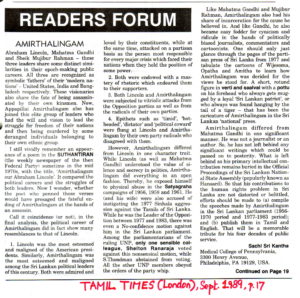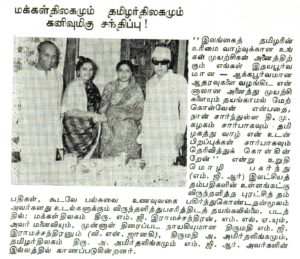by Sachi Sri Kantha, August 31, 2018
Since 2001, I had covered Appapillai Amirthalingam’s life and politics in this website under various themes. Here is a select list of five items which have not been covered by other chroniclers of Eelam. Most importantly, details presented in these five items will hardly appear the Wikipedia version on Amirthalingam’s profile, for obvious reasons like entry- tampering by non-Tamil individuals, to present a squeaky clean image of an “LTTE-assassinated” Tamil politician.
- Amirthalingam’s historic speech in the Sri Lankan Parliament (2003) http://www.sangam.org/ANALYSIS/Sachi_8_25_03.htm
- Perversity of Pyromaniacs – Part 1- Revisiting the June 1981 Torching of Jaffna (2006) http://sangam.org/taraki/articles/2006/0604_Torching_Jaffna_1.php?uid=1757&print=sangam
- Perversity of Pyromaniacs – Part 2- Amirthalingam’s speech on the Torching of Jaffna in May-June 1981 http://sangam.org/taraki/articles/2006/05-04_Torching_Jaffna_2.php?uid=1758
- Amirthalingam on the events of May-June 1981 and Army behavior in Jaffna (2011) http://sangam.org/2011/06/Amirthalingam_1981.php?uid=4383
- On Mrs Mangaiyarkarasi Amirthalingam: Her tongue and her dirge song (2010) http://sangam.org/2010/10/Mangayarkarasi_Amirthalingam.php?uid=4086

Tamil Times, Sept 1989 -Amirthalingam eulogy
Amirthalingam’s 91st birth anniversary passed by on August 26th. I take this opportunity to present a balanced posthumous profile of him authored by B. Krishnakumar in the Weekly (Kochin) magazine, dated July 23, 1989. I received this profile from UK, from an anonymous source, after the appearance of my brief eulogy to Amirthalingam in the Tamil Times (London) monthly of September 1989. I present a scan of my eulogy nearby. In this, I had compared the political careers of Amirthalingam to that of Abraham Lincoln and Mahatma Gandhi. I was partly inspired to write this eulogy then, because in the Sutantiran weekly (then owned by the Federal Party’s founder S.J.V. Chelvanayakam) around 1970s, I saw a poem published with a catchy, rhyming title, ‘Amirthalingan – Our Abraham Lincoln’. At that time Kovai Mahesan, the editor of the Sutantiran, was an active sympathizer of Amirthalingam. Subsequently in late 1970s, that he and M.K. Eelaventhan were thrown out of TULF by Amirthalingam was a separate story itself.
As T. Sabaratnam, Amirthlingam’s biographer, failed to acknowledge some dents in the personality of Amirthalingam, first I present Krishnakumar’s profile for public record, and then comment on cryptic messages presented in it.
***************
Amirthalingam always played it safe: The Last Moderate
by B. Krishnakumar
Death struck as discreetly as Appappillai Amirthalingam used to conduct his politics. He, along with trusted lieutenant V. Yogeswaran, was gunned down in the quiet of his residence in Colombo as he was conferring with party chief M. Sivasithamparam. Amirthalingam and his Tamil United Liberation Front (TULF) were for long marked for elimination. The Tamil militant groups of Sri Lanka never forgave the party and Amirthalingam, its all-powerful secretary-general, for sticking to compromise politics. Both were living on borrowed time – courtesy Delhi and Colombo. And the end, for Amirthalingam and with his passing most probably for TULF, came around 7:30 pm on July 13. Amirthalingam’s brand of Tamil nationalism had earned him many enemies, and their long arm finally caught up with him.

Amirthalingam and MGR in Madras, Feb 1972
The septuagenarian was a practiced practitioner of the crafty art of the possible. Even after the Sri Lankan Tamils’ fight for autonomy blew up into a full-scale insurgency, Amirthalingam clung to his democratic beliefs.
Words, spoken in quiet conviction, not guns, were the stuff of his considerable political armoury. He preferred political negotiations to gun-point diplomacy much to the chagrin of the militant groups, especially LTTE which kept its guns trained on him.
Amirthalingam was no Mahatma, though. Consequently he moved into the safe and cosy sanctuary of the government guest house in Madras courtesy the late M.G. Ramachandran. For all his pampering LTTE, the late Tamil Nadu chief minister ensured that it did not touch Amirthalingam as long as he was in his ‘protective custody’.
But then he lost his moorings back in Jaffna where he was virtual king till the vicious ethnic riots of 1983. The party he headed, Tamil United Liberation Front, too virtually moved its headquarters to Madras, thus alienating the Tamil masses. Though he and the Indian government projected TULF as the voice of moderate Tamils, it was drowned out by the booming LTTE guns.
Yet he continued behind-the-scenes manoueuvres to get the Tamil militants and Sri Lankan government to the negotiating table. The Thimpu talks of 1984, he once told THE WEEK, was his baby. He had convinced New Delhi to pressure the militants even as he renewed his political contacts with the Colombo establishment. During his long years as the MP from Jaffna, Amirthalingam had cultivated Sinhala politicians who now responded to the initiative.
The militants grudgingly fell in line then, but never tired of recalling how Amirthalingam nearly betrayed them. The LTTE leaders, especially, would snigger that Amirthalingam was a coward who would sooner or later pay for his ‘petty politicking’. Ever since, he had been totally isolated from his own people, though he continued to have a big say in the official exchanges between Delhi and Colombo. In a way he even prepared the ground for the Indo- Sri Lankan agreement of 1987. It was as much an initiative to end the bloody confrontation as it was to rein in LTTE which he considered a bunch of misguided hot-heads.
Once LTTE gunned down the accord, Amirthalingam was again high on its hit-list. The crafty politician had moved house and headquarters to Colombo in his capacity as TULF chief and MP because he was a persona non grata in Jaffna. A fact that made him shift his political moorings to Baticaloa during the provincial elections, only to be snubbed by the Tamils there. He lost the bid to retain his seat in Parliament. It was left to President R. Premadasa to include him in the ‘national list’ of MPs, a move that, in the eyes of LTTE, only confirmed his status as a self-promoting establishment stooge.
Though he did cosy up to the Indian government, if only for self-preservation, he never really appreciated Delhi’s manipulation of the militant groups. In private he used to debunk India’s policy of encouraging the militants especially LTTE which he predicted would grow into a law unto itself. But on record, his stand was of a carefully-treading politician. “India knows best”, he would say with a wry smile. In a way, as his intractable foes insisted, Amirthalingam put self and family before the Tamil cause. Made in the mould of the Indian politician, he had continued to operate from the air-conditioned comforts of Madras. His family too were well cared for – some of his kin are settled in London.
Along with Yogeswaran and party chief Sivasithamparam, Amirthalingam controlled TULF funds, too. One reason for the militant ire against him was his refusal to fund their campaign even in the initial days. Militant guns had dispersed the party cadre and of late it has\d been reduced to a three-man party. And the July 13 strike all but wiped out the party – Sivasithamparam, who survived the attack, is hardly likely to have any sympathizers left.
His death, as his political pursuits, is cloaked in intrigue. Though LTTE is the prime suspect, why would it kill him just when it has had a patch-up with Colombo, his patrons? Was his elimination one of the baits used to lure LTTE to an accord? In the violence-clouded no man’s land that is Lanka today, the extremist Sinhala group, Janata Vimukthi Peramuna (JVP) is a suspect. One thing is certain: Amirthalingam was set up. Who or why may never be known.
*****************************
My Comments
A factual error in the 2nd paragraph needs correction. At the time of his death, Amir was a sexagenarian, and not septuagenarian.
The two sentences related to MGR’s hospitality to Amirthalingam and his fellow TULF MPs was a fact. Here, MGR’s magnanimity is revealed. Though Amir was partial to M. Karunanidhi in his leanings, MGR for his own reason (humanitarian or political or both) made sure that Amir and his family would be taken care of benevolently. Nevertheless, Amirthalingam failed to learn a vital lesson from MGR’s political play book. Whereas MGR never allowed RAW guys to dictate terms on his decisions, Amirthalingam danced to the tune of RAW posse. This was his ultimate downfall.
In the final chapter of his biography, Sabaratnam mentions that Kunwar Natwar Singh (b. 1931) as the representative of the Indian government, made a moving funeral oration to Amirthalingam, with the following sentiments: “Amirthalingam had toiled for the unity of Tamil militant groups since 1984. He had had several meetings with militant leaders, had pleaded with them to get together. His heart bled when they fought among themselves, killed each other. He had made use of every chance he got to meet them and each time he had begged them to come together.” What was hidden in Natwar Singh’s 1989 oration was the spoiler role played by the RAW’s gumshoes, and how RAW set up and induced Amirthalingam for his premature death in 1989. Subsequent developments in the political career of Natwar Singh (who then played a bucket carrier role to Rajiv Gandhi) in the next 25 years until 2014, indicates what a rotten Indian politician he turned out to be. Even Sabaratnam had failed to delve deeply into Amirthalingam’s interactions with the RAW folks.
The final paragraph of Krishnakumar’s obituary profile is of much interest. Excluding the penultimate sentence related to JVP as ‘a suspect’, which I consider is a stretch, other details have not been solved clearly. Missing are the details related to Amir’s contact with India’s gumshoe agency, RAW, though the final paragraph began with an allusion that Amir’s death “is cloaked in intrigue”, and ended with “Amirthalingam was set up. Who or why may never be known.”

Neena Gopal
The answer to the last sentence in Krishnakumar’s profile is this, Amirthalingam was set up by the RAW. “Who or why” is now becoming more clear. RAW wanted Amirthalingam as the sacrificial ‘queen’, in its political chess game with the LTTE and the Premadasa government. Amirthalingam’s assassins were Gopalapillai Mahendrarajah’s (aka Mahattaya) men. And all three of his assassins were killed instantly. Two years ago, journalist affiliated to the Deccan Herald, Neena Gopal had published a book, ‘The Assassination of Rajiv Gandhi’, and she had identified Mahattaya as RAW’s mole. [Slain LTTE chief Prabhakaran’s deputy was a RAW agent: book, Times of India, Aug. 16, 2016]. Indeed, this was my hypothesis, which I first articulated in the Pirabhakaran Phenomenon series presented in this site in 2001, and published in my Pirabhakaran Phenomenon (2005) book. Suppose Amirthalingam had opted to live in political retirement in Chennai, rather than not returning to Colombo, his fate would have been different.
One particular sentence in this profile. “Amirthalingam was no Mahatma.” is a beauty. Though by professional training and inclination, both Mahatma Gandhi and Amirthalingam were lawyer-politicians, Mohandas Karamchand knew when to shut his mouth in political games, but Amirthalingam never learned this trick.
Cited Sources
- Krishnakumar: Amirthalingam always played it safe: The Last Moderate. The Week (Kochin), July 23, 1989, p. 32.
- Sabaratnam: The Murder of a Moderate – Political Biography of Amirthalingam, Nivetha Publishers, Dehilwela, 1996.
Sachi Sri Kantha: Amirthalingam. Tamil Times (London), Sept. 1989, p. 17.
Sachi Sri Kantha: Pirabhakaran Phenomenon, Lively COMET Imprint, Gifu City, Japan, 2005.